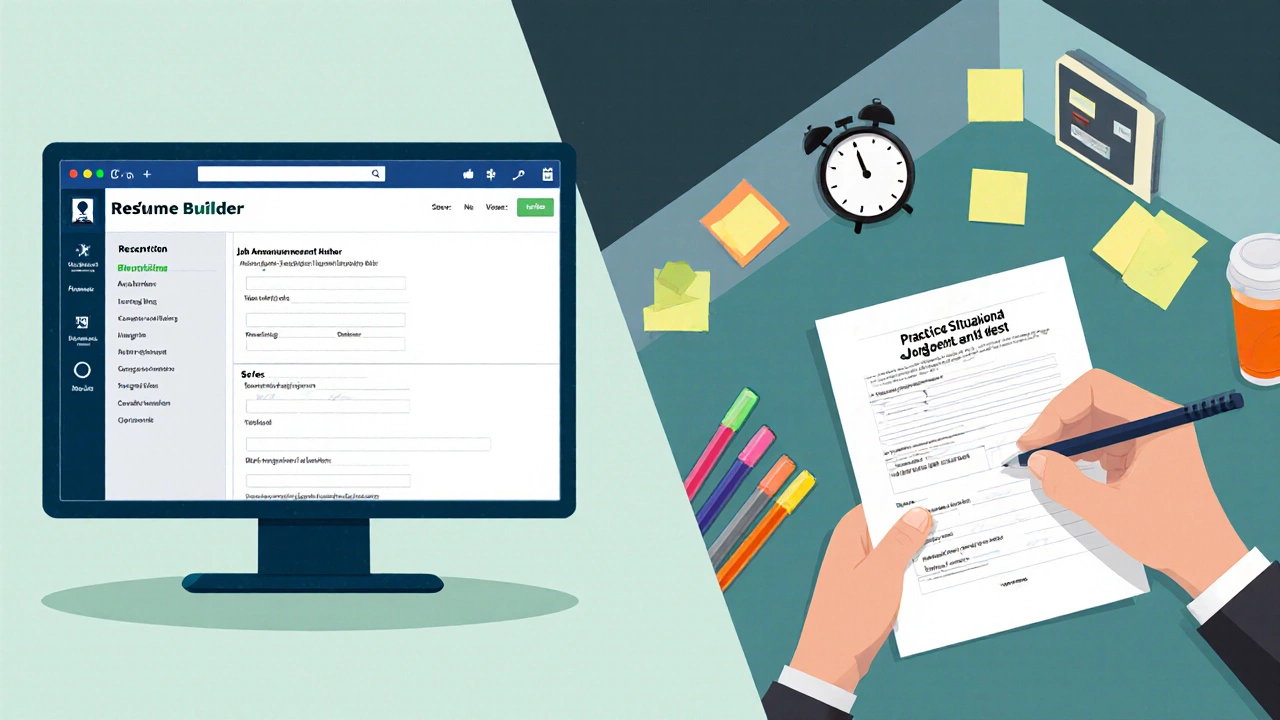Want to work for the Federal Government Jobs is a career path that offers stability, benefits, and the chance to serve the public but aren’t sure where to start? This guide walks you through every move you need to make - from figuring out which jobs fit your skill set to polishing a federal‑style résumé, cracking the exams, and sailing through the interview process.
Know the Landscape: Job Types and Hiring Paths
The federal workforce is split into three main hiring authorities. Understanding them helps you pick the right route:
- Competitive Service is the most common track. Positions are posted on USAJobs and require you to pass a merit‑based exam or assessment.
- Excepted Service includes roles that need special qualifications, such as intelligence or legal positions. These aren’t always posted on USAJobs.
- Pathways Internship Program is designed for students and recent grads. It offers paid internships, recent‑graduate positions, and fellowship tracks that can convert to permanent roles.
Most entry‑level seekers start with Competitive Service or Pathways, so the rest of this guide focuses on those two.
Step 1 - Check Eligibility and Gather Documents
Before you even log into USAJobs, you need a clear picture of the basic requirements:
- U.S. citizenship (or a legal work permit for certain agencies).
- A bachelor’s degree for most professional tracks, or a relevant associate degree for technical roles.
- Subject‑matter expertise that matches the job announcement’s “Qualifications” section.
- Any special eligibility, such as Veterans' Preference, which gives qualified veterans extra points in the rating process.
Gather transcripts, DD214 (for veterans), SF‑86 security‑clearance forms, and any professional certificates you already hold. Having these PDFs ready will save you hours later.
Step 2 - Master the Federal Resume
The federal résumé is a different animal than the private‑sector one. It usually runs 3‑5 pages, uses the federal government jobs keyword naturally, and follows a strict format:
- Job Information: Include job announcement number, series, and grade.
- Work Experience: List each position with exact duties, achievements, and the number of hours per week. Use active verbs and quantify results (e.g., "Reduced processing time by 22 % through workflow automation").
- Education: State your degree, major, institution, GPA (if 3.0+), and any relevant coursework.
- Additional Information: Security clearance level, languages, publications, and volunteer work.
Take advantage of the built‑in résumé builder on USAJobs. It forces you to fill in each required field, guaranteeing compliance with the Office of Personnel Management (OPM) guidelines.
Step 3 - Target the Right Job Announcements
Use the filters on USAJobs to narrow down opportunities:
- Location (or “remote” for telework‑eligible roles).
- Series (e.g., 0343 for Management Analyst, 2210 for Information Technology).
- Grade (GS‑5 to GS‑9 are typical entry levels).
- Keywords such as “entry‑level,” “recent graduate,” or “veterans' preference.”
Read the “Qualifications” and “How to Apply” sections word‑for‑word. Missing a single required document can disqualify you automatically.
Step 4 - Prepare for the Assessment or Exam
Most Competitive Service jobs require an assessment. Common formats include:
- Situational Judgment Test (SJT) - evaluates how you would handle workplace scenarios.
- Multiple‑Choice Knowledge Test - covers technical knowledge for the specific series.
- Structured Interview (also called “rating and ranking”) - interviewers score your responses against a rubric.
Resources for preparation:
- Official practice tests on the OPM website.
- Study guides from the Federal Government Exam Prep community on Reddit.
- Free courses on Coursera that cover basic civil‑service topics, such as project management or data analysis.
Schedule a quiet, uninterrupted 2‑hour block for each practice session, and treat the test as a timed exam to build stamina.
Step 5 - Get Your Security Clearance (If Needed)
Many federal roles, especially in defense, intelligence, or IT, require a background investigation. The clearance process can take weeks to months, so start early:
- Fill out the SF‑86 (Questionnaire for National Security Positions).
- Gather supporting documents - financial records, foreign contacts, and prior addresses.
- Be truthful; any discrepancy can lead to denial or later revocation.
If you’re applying through Pathways, many agencies waive the clearance for the internship phase, giving you a chance to earn it later.

Step 6 - Nail the Interview
Federal interviews differ from corporate panels. Expect a structured format where each answer is scored on a 1‑5 scale. Use the “STAR” method (Situation, Task, Action, Result) and tie every response back to the KSAs (Knowledge, Skills, Abilities) listed in the vacancy.
Sample question: “Describe a time you improved a process that impacted multiple stakeholders.” Answer with a concise story, quantify the improvement, and mention the collaboration tools you used.
Step 7 - Follow Up and Keep Applying
After you submit your application, you can check status on USAJobs. If you receive a “rejection,” request feedback through the agency’s human‑resources contact. Use that insight to tweak your résumé or study plan, then apply to the next posting.
Persistence pays off. In FY 2024, roughly 30 % of first‑time applicants secured a position after applying to three or more jobs.
Pathways vs. Competitive Service - Quick Comparison
| Feature | Pathways | Competitive Service |
|---|---|---|
| Eligibility | Current students, recent grads (≤2 years), or those in a qualifying fellowship | U.S. citizenship, typically a bachelor’s degree; no age limit |
| Typical Grade | GS‑5 to GS‑7 (intern), GS‑9 to GS‑11 (recent‑grad) | GS‑5 to GS‑9 for entry‑level |
| Exam Requirement | Often none; may include an assessment | Usually a merit‑based exam or structured interview |
| Conversion to Permanent | Internships can lead to direct conversion after 1 year | Permanent after successful completion of probationary period |
| Benefits | d>Standard federal benefits; some agencies offer tuition assistance | Full federal benefits package, including retirement and health |
Pro Tips From People Who Made It
- Leverage networking. Attend agency‑hosted career fairs and connect on LinkedIn with current federal employees. A referral can move your application to the top of the pile.
- Tailor every application. Use the exact language from the vacancy when describing your KSAs - the automated rating system looks for keyword matches.
- Document volunteer work. Many agencies value public‑service experience, even if it’s from a local non‑profit.
- Stay current on hiring freezes. Check the Office of Management and Budget’s (OMB) website for agency‑wide hiring pauses, especially during budget cycles.
Next Steps Checklist
- Create a USAJobs account and upload a federal‑style résumé.
- Identify 3‑5 target agencies and set up email alerts.
- Complete at least one practice assessment for each series you’re interested in.
- If you’re a veteran, request VA Form 22‑1990 for veterans' preference.
- Start the SF‑86 security‑clearance questionnaire if the job calls for it.
- Schedule mock STAR‑method interviews with a friend or mentor.
- Apply, track status, and iterate based on feedback.

Can I apply for federal jobs if I’m not a U.S. citizen?
Most competitive‑service positions require U.S. citizenship. Some agencies sponsor visas for highly specialized roles, but those are rare and usually posted as “Citizenship may be waived.”
Do I need a security clearance to get a federal job?
Only if the job announcement lists a clearance level (e.g., Secret or Top Secret). You can still apply without one; the agency will start the investigation after you’re tentatively selected.
What’s the difference between a GS and a SES position?
GS (General Schedule) is the standard pay scale for most civil‑service employees, ranging from GS‑1 to GS‑15. SES (Senior Executive Service) sits above GS‑15 and is reserved for top‑level managers and policy makers.
How long does the hiring process usually take?
From posting to final appointment, it can range from 30 days for a fast‑track internship to 90‑120 days for a full competitive service role that requires a clearance.
Can I transfer a federal job from one agency to another?
Yes, through the “inter‑agency transfer” process. It typically requires at least one year of satisfactory service in your current position and a vacancy in the target agency.
